MY MEMORIES OF BISHOP'S HULL
by
Christine Laura Quartly
February 2001
I was born in Bishop's Hull - to be exact, in the bedroom above the bar, overlooking the churchyard, at the New Inn, which is now known as the Cavalier; as was my brother, Rod, before me. As was often the case, our mother returned to her mother's home to have her babies (although Grandpa insisted that I was bought at Woolworths - the middle doll on the top shelf!)
Grandpa was Captain William Durman and the landlord of the Inn. He had had a very adventurous life - he went to sea when he was 13 years old and was granted his Master Mariner's Certificate by the Ministry of Marine and Fisheries of Canada when he was 28. He travelled the world, but chiefly in the Far East. He would sit and doze, suck his pipe and relive his adventures. He retired from the sea in about 1900 and he and grandma came to Bishop's Hull in 1905 with their two daughters, Laura and Adele (mother).
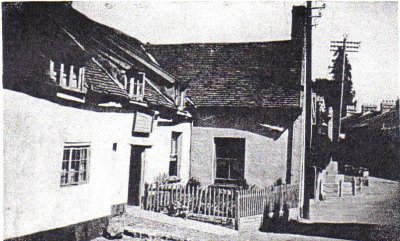
During the first world war, a ladies' band of ringers was formed by Mr. Perce Merson of Church Row, and my mother and Aunt Laura were keen members. In fact, mother continued with bell ringing well into her 70's. My mother and father were married in our Parish Church, and Rod and I were both christened there.
|
The ringers were: Mr Perce Merson, who lived at 1 Church Row. |
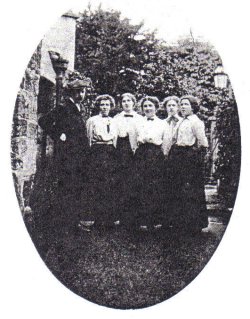 |
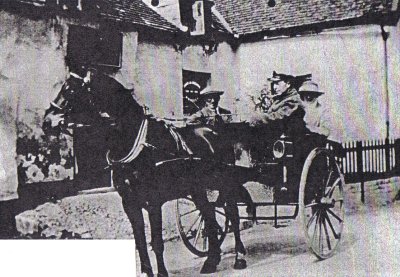 |
My father (Frederick Channing) and Mother (Adele Durman) with Mr. Jack Davey of Roughmoor during the First World War (about 1917) |
At that time, Bishop's Hull was a much smaller village - no Lowlands Terrace - this was an orchard, probably because Mr. Dimond's farm opposite (Haydon Farm) was well known for its farmhouse cider. The cottages at the beginning of Mountway Road (known locally as 'the Pigeon Holes') and the Smithy were the only buildings on the right hand side. Approaching Mountway Lane was a derelict old house belonging to a Mr. Hanbury - it was left untenanted but fully furnished for so long that eventually it fell down ... this house was haunted!!! In Mountway Lane was a row of old cottages on the left-hand side, and the track just continued down to fields with a footpath, which came out by Greenleaves; and another, which came out at Tytherleigh. Silkmills Road has, of course bisected our village, but if one can forget this busy road, new development has not hit Roughmoor to any degree but what about when a bridge is built over the railway!!!!
| The old bridge at Silkmills that spanned the derelict Tiverton to Taunton Canal. | 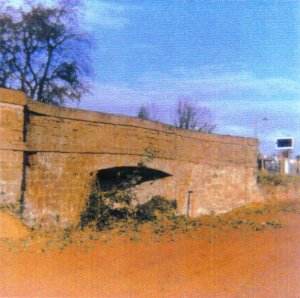 |
As regards the centre of our village, the Vicarage has gone, and the open areas of garden and orchard between the New Inn and the Manse have rather overwhelmingly disappeared. Shutewater Hill has just the cottages to the left, and Bishop's Hull Road had no houses on the right beyond the Chapel until one reached the then isolated Red Lion (now Stonegallows Steakhouse). Mrs. Rawlins, a little lady who always wore a black toque hat, occupied the Manor House. She had numerous black tongued chows - and tiger skin rugs with stuffed heads in her hall.
The hub of the village consisted of the New Inn (Grandpa); the Church (the Revd George Rabin); the Baker's Shop (Mr. Baker); the Post Office (Mr. Turner); the Grocer (Mr. Collard); The Old Inn (Mr. Durman); the Butcher's Shop (Mr. Irish); and the Chapel. All the social events of the village, and the Sunday School were held in the Church Hall (down the lane by the Butcher's). It has all altered - some gradually and some more speedily over the last 20 -30 years. However, we still have an attractive village with a good playing field area in the centre, where people want to come to live.
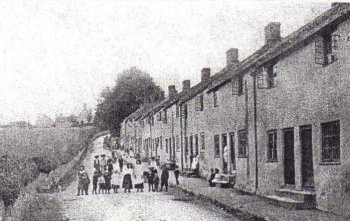 |
Shutewater Hill about 1905. The windows are changed, and many have porches, but from the front, very little difference today. |
| Mr Baker's Bakery and the old thatched and cobb built cottages were pulled down in 1911. | 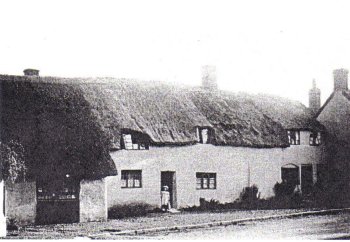 |
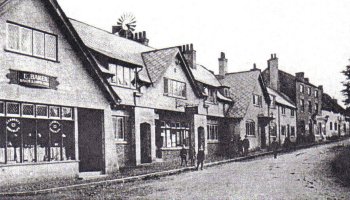 |
The same area after redevelopment in 1912. The Post Office is in the centre. |
The field from which this view of the church and vicarage was taken, was part of Parsonage Farm, and was often loaned by the farmer, Mr. Biffen for the Church Fete. The Vicarage was demolished in 1967, and the land used to form a car park, and later for the Church Hall which was acquired from Queen's College. The field was purchased when the farm was sold for the village playing fields.
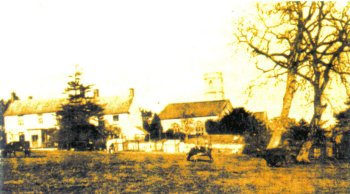 |
|
Present view today
|
 |
| This view shows the Butcher's Shop; the adjoining building, which is now the post office and shop, was the living part of the property. The shop, which I remember as Collards, is now part of the Old Inn, as is the house adjoining. |  |
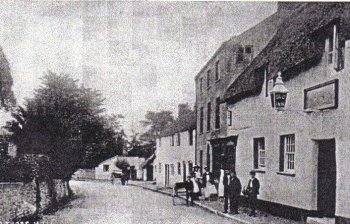 |
This view shows the Old Inn to the Baker's Shop. It is interesting to see that the left-hand side is very much the same as it is now, except for the hedge and over hanging trees, which would definitely impede modern day traffic. This photo was taken in 1904. |
The mill at Roughmoor Bridge was principally a flourmill. It was originally joined to Tytherleigh by a footbridge and weirs. I can remember Mrs. West living there with her brother, Mr. Jack Hutchings. Mrs. West's daughter Edith married Walter Slipper, and their son, Bill and his wife Ann live there now. The mill ceased to be used before the First World War.

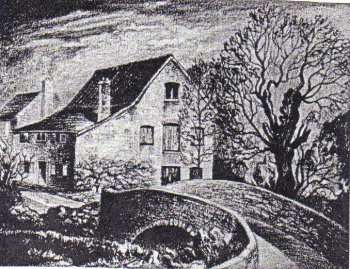
There was also another mill further along Roughmoor Lane, fed by the Norton Brook. This was where Tommy Maddocks lived. His daughter, Mrs Bessie Martin, wrote a wonderful article on Bishop's Hull as she remembered it, and this was included in the book prepared at the time of the Silver Jubilee.
The photo below is of my brother Rod on the weir. This has all disappeared now.
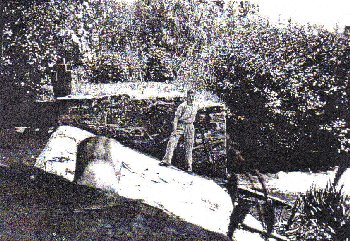
I started school in the village when I was three and a half, the headmaster being Mr. Blatchford.
The photograph below was taken about 1926 - some of the older members of the village may recognise some faces. You should, however, know the little boy and girl, nos. 5 and 6 from the left in the back row.
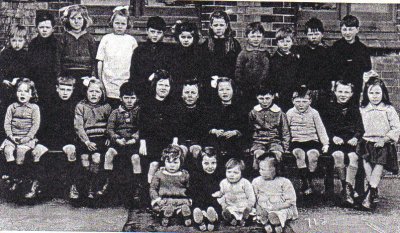
We moved to Stoke Canon when I was five, but still had strong ties with Bishop's Hull. It was quite a short rail journey to Norton Fitzwarren and a quick walk either through Longaller Farm or along the canal bank to Netherclay, which brought us to the village.
Grandpa and Grandma died in 1937 and Aunt Laura took over as Licensee. Before war broke out in 1939 the roof, the first floor and the adjoining cottage to the Inn were demolished, and the property was rebuilt as it is today.
In 1940 my father retired and we returned to Bishop's Hull. These were war days, and all the younger men were disappearing to the forces. I worked for the Glen Line Shipping Company, which had been evacuated from London to Upcott Hall to be safe from bombing as the firm dealt with convoys of ships to and from our ports.
Later I joined the Women's Land Army, After a brief training at Cannington Farm Institute (photo below).

I worked for the War Agricultural Executive Committee, and travelled to farms all over Somerset pruning apple trees. However, when I had the chance to work for Mr. Venn at Newley Farm, I jumped at the opportunity. The photo below shows another landgirl and I helping with the harvesting at Newley Farm. I met Dennis there and we were married by the Revd. George Raban in 1944, Dennis and I lived at Hillmore.

There were many more farms in the village at that time:
Roughmoor Farm - farmer Mr. J. Davey. His son, Philip, still owned the land, which was let, until sadly he died in December 2000.
Parsonage Farm - farmer - Mr. Biffen. Mostly sold except one field at the bottom of Netherclay Hill, which has 4 footpaths crossing it and one behind the houses on the right hand side of Bishop's Hull Road. The remainder was sold for housing development and our playing field and Community Centre.
Haydon Farm - farmer - Mr. Dimond. This farm changed hands, but the land was sold off chiefly for housing development.
Hillmore Farm - fanner - Mr. Harold Quartly. Land still owned by the family, but let as grass keep to Newley Farm.
Longaller Farm - farmer - Mr. R. Gregory. This was a large farm and mill. The land has now been taken over and run by Newley Farm.
Newley Farm - farmed by Messrs. W. J. Venn and Son. The only remaining working farm in the village, which has enlarged over the years, taking in land at Rumwell. For a while they bought the old Baker's shop to sell principally, their produce. They also had numerous electric vans delivering milk around the whole village and beyond. Now milk from their 2 large herds - Jersey and Friesian - is collected from the farms by huge container lorries. They have a shop at Newley Farm now for the sale of their fresh laid eggs, hens forming a considerable part of their farming business. Our last village working farm...

As time went on we unexpectedly had 2 baby boys one was expected, but two was a surprising bonus. Housing was very difficult after the war - no building having been carried out and many servicemen returning from the forces looking for homes. We rented a cottage behind the New Inn to bring our babies home and were very happy there. Our boys, David and John were christened in the Parish Church, where I had been christened and my mother and father had been married.
At the top of the track in front of our cottage was the old Malthouse, which we rented from the Brewery, Starkey, Knight and Ford. In this we kept pigs and poultry. We also rented from the Chapel the orchard, which was between the New Inn and the Old Manse. Here we kept geese, turkeys and chickens, but chiefly it was somewhere for our boys to play. The picture below shows the boys in the orchard and the backs of the cottages opposite the Old Inn.

This orchard was the land on which Malthouse Court was built. Later Parsonage Court was built on Parsonage Farm land and part of the vegetable gardens of the New Inn and New Inn Cottages. These two large developments can be seen in the photo below, which was taken from the fields in front of Frethey House. The Church can no longer be seen on the top of the hill.

Celebrations were held in the village in 1952 to commemorate the coronation of Queen Elizabeth 11. Amongst other events a fete was held which included fancy dress competition for children. Our boys went as the Bedser Twins - I can't remember if they won a prize. I don't expect so.
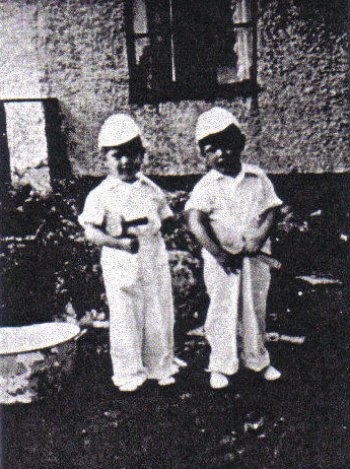
Our boys started school (in Gypsy Lane) when they were 5, and I returned to work for the War Agricultural Executive Committee. I remained there for 25 years.
Dennis & I bought our bungalow in Shutewater Close in 1967. All development in Shutewater, with the exception of houses and cottages on the left-hand side, were built since the war. The land on which Farrant Close now stands was allotments - the revenue from which helped to finance the Nursing Association. The village nurse lived in the last house on the right at Netherclay. She rode a bicycle and was at the beck and call of all - day or night. When I was about 8 she helped Dr. Joslin to remove my tonsils on the kitchen table!
Shutewater Close was built on a steep meadow - very popular for tobogganing during snowy weather.
The next memorable time for the village was during the period around the time of the Queen's Silver Jubilee 1977. This national celebration was near the time when the village was so excited at the provision of a new school, including part use as a village hall, and playing fields.
We were very lucky to have Mike and Sue Sharp living at Wheel House at this time. Mike was an organiser who drew everyone in to help with Jubilee events, which stretched throughout 1977, and Sue was such a talented musician, who persuaded us all that everyone could play some instrument - mine was a comb!
We had street parties - below shows the one in Shutewater Close.

It was also decided to commence editing a village news sheet - and so The Community News was born, the first being the Jubilee Edition in June 1977. Mike edited the first few and then Bill Kennedy and I took it over, later with the help of Bob Parker, until March 2000. It is still going strong, and is now edited by Bob, Ray Court and Pam Mildon.
I have attached copies of the first 2 editions - these can show better then I the spirit then alive in the village; and all the many events organised to celebrate Her Majesty's Silver Jubilee.
The photo below is the Jubilee Cake. The 36 individual sponge cakes were made by various village ladies, and it was iced by Jean Hooper, then living at 1 Shutewater Close.

The village has grown and changed a lot. Hillmore was pulled down, and houses built on its site, and on the paddock and the orchard, also on the fields which were part of Parsonage Farm, and Mr. Rosewell's field on the corner of the Trull Cross Roads.
Waterfield Drive is on the site where the footpath crossed the fields to the Wellington road near the brick yard. This was named after Miss Phoebe Waterfield who had lived in Bishop's Hull House, and later in Eagle House, which she had built in the grounds of Bishop's Hull House. She was a very active member of the Parish Council, and a very popular figure in the village.
It was at this time that work was in full swing on the Silkmills Road. Tuesday 3rd October 1978 was the first Bingo evening, organised by Barbara and Fred Gamlin on behalf of the Village Hall Trust all profits being for the Trust funds. This is still a very popular event each week, now arranged by Sylvia Lee and helpers as Bishop's Hull Bingo Club. Although they pay no rent for the room, all the profits still are given to the Trust funds.
On 6th December 1979 thirty Bishop's Hull people attended a meeting of Taunton Deane Leisure and Recreation Committee to make their hopes known that the expensive piece of land in the Centre of the village should be purchased for our use as playing fields. The Chairman stressed the feelings of the Committee that help should be given to those who helped themselves, and that Taunton Deane should provide the money for the purchase of this land, which would otherwise be built on. We were very proud of our village on that day. The Parish Council voted a 4p rate, which proved the Chairman's point. This money to be used towards leveling work - it was a much steeper field than it is today. Dennis and I attended this meeting, and we can all still appreciate the decision made that day.
On Sunday, 23rd September 1985, "Stoneybroke" was officially opened by the Mayor of Taunton Deane. This house, Mr. Frank Bond's home, was left in his Will for the use of older citizens of the area. It has since been used to give great pleasure to many. By paying an annual subscription of only £3 so many weekly events can be enjoyed - Coffee Mornings, Croquet, Whist, Keep Fit, Painting, to name just a few. You can always be sure of a nice cup of tea or coffee and a friendly face.
It was also in 1985 that the first Car Boot Sale was held in the Playing Fields. On that first sale 40 cars arrived and a profit of £100 was realised for Trust funds. By July 1991 the number of cars arriving for the sale, some queuing from before 6.00 a.m., had risen so alarmingly, and the congestion caused so difficult to control, that the cost of entry was raised to £5 per car and £10 for vans/trailers. The numbers of cars have now fallen off, probably due to the number of other sales elsewhere.

Peter Roebuck, Somerset's opening batsman, officially opened the new sports pavilion in the playing fields on 6th May 1985.
My strong and previously healthy Dennis died on 12th December 1985. He still sways my decision on problems.
In August 1986 the Parish Council decided to erect a public seat on the grass verge of the A. 3 8 at Rumwell. A nice walk, but also a reminder that this is part of the Parish of Bishop's Hull.
In May 1987 the recently erected St. Margaret's Hospice in Heron Drive received its first cancer patients.
The signal box at Silkmills was unmanned May/June 1987, and two television cameras installed alongside the track to give a clear picture to the signalman controller in Exeter. Under the new system, we were told, the barrier arrangements would work faster! In February 1988 a request was made to British Rail for an improvement in the way the gates were operated. A survey recorded that the barriers were lowered for 7 minutes without a train passing! How long before the proposed new bridge will allow more traffic to travel even faster towards our split village?
The Church Hall was erected in the Church car park, which was previously the site of the old Vicarage in January 1988.
In April 1988 demolition was carried out behind the Constitutional Club to make way for the new snooker hall. A well was uncovered a few feet behind the Club and the adjoining cottage. The depth was measured very accurately by means of a brick on the end of a rope! It was found to be 50ft with about 25ft of water. The well was beautifully lined with bricks and was about 5ft in diameter.
Just think what an undertaking it must have been to dig so deep a hole - undoubtedly by hand - and what a task to bring up the soil. Old pictures of the village show the top of a windmill behind these houses, (see page 7). The water from this well may have been pumped some distance, as it is unlikely that the cost of erecting a windmill would have been considered worthwhile for just the immediate cottages, which were rebuilt in 1912.
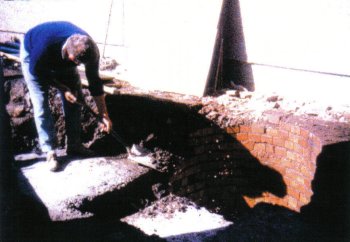
From 11 April 1988 the BBC extended its local radio coverage of Somerset by setting up Somerset Sound in Taunton.
The Old Cedar Tree outside Meryan House Hotel was felled in 1992 as it was considered unsafe. This completely altered the appearance of the centre of the village.
The War Memorial
The names of the fallen in the First World War had become so eroded, and those of the Second World War had not been added, so the Parish Council decided that there should be new bronze plaques and inscriptions giving the names of the fallen in both World Wars.
On 9th February 1993, Col. Sir John Lawson unveiled these, and school children planted a tree. Prayers were said by our Vicar, Rev. Colin Randall, and the Last Post and Reveille were sounded by buglers from Wellington School CCF. The Taunton Deane Mayor, Mrs. Margaret Dickson and a contingent of the British Legion as well as many people from our village attended the ceremony. Photo overleaf.
Hillview Stores closed as a general village grocery shop on 31st July 1997. We were all very sad, as we would miss the social chat we always expect in all our village shops. Jenny and Alan have changed to a Bed and Breakfast establishment, having extra rooms prepared to the rear of the shop - where the loaves were baked when this was a Baker's Shop owned (would you believe it) by Mr. Baker! Bread was delivered throughout the village and further even if you lived next door!
Bob Parker with the help of Marilyn Jorgensen and Molly Burgess, organised the first Art Week 4th 8th November 1997. 90 paintings were on display and it was voted a great success. It has been an annual event since.
Bob joined our Community News team in January 1998.
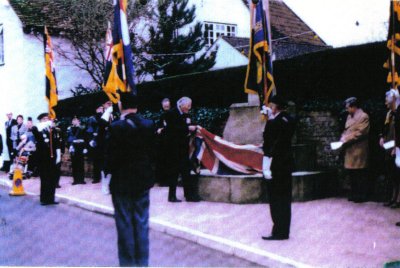
We now have a bus service to the town every half-hour from Farrant Close - single fare, I think, 92p. The first bus service I can remember started at the Church and continued to the town - down St. James's Street to Lambrook - turned and came back. I think about every hour. I do remember that the fare all the way was 2d.
BISHOP'S HULL 2000.
Various organisations arranged their own celebrations, and the steering group, chaired by Carol Bulbeck were on hand to encourage their efforts, and also arrange village events: -
Social evening with Robin Bush to talk about our village in the past.
New road signs on 4 roads approaching the village.
The site of the gallows at Stonegallows marked with a large stone.
Plans to repair the footbridge behind Netherclay House.
Plans to form a Youth Club in the village.
The 2 Churches are planning a Millennium Garden in the Church car park; and a Wall hanging to be worked in the Millennium year by people of the village.
Surveys of village life, hedgerows, village gardens and their contents, also paintings of the village now and then, organised by Bob Parker.
Various special services in both Churches and a 5 minute peal of bells at 12.00 a.m. - also rung out nationwide at this time.
The increased use of the car has caused the biggest change and problem in the village. Narrow roads with houses built at the time when cars were unknown, therefore they have no means of garaging and must park on the road. Also many houses with garages now fill them with overflow from their houses and still park on the road. We are lucky that the main road to Exeter does not still pass through the village.
The longest running events in the village are the Flower Show and the Fete. Attached you will see the 1925 programme (please note, we hope to publish this soon) - Bishop's Hull Fete, Gymkhana and Flower Show. It was held in our field on Bishop's Hull Road. As you know the Flower Show and Fete are now organised separately, and we must support these events to make sure they keep alive. We appreciate the consistent hard work needed by the organisers to keep these events on the road.
The bits and pieces noted since 1977 I have found in the Community News. Bill and I resigned in March 2000 after 23 years. We both enjoyed working on this village news sheet very much.
The Community News gives quite a history of village life since 1977 - some interesting and some everyday. I have kept a complete set and they make very interesting reading.
There was a time when we knew everyone in the village, but with the development that has occurred since the war this is impossible. But the village is great - that is why so many people want to come here to live.